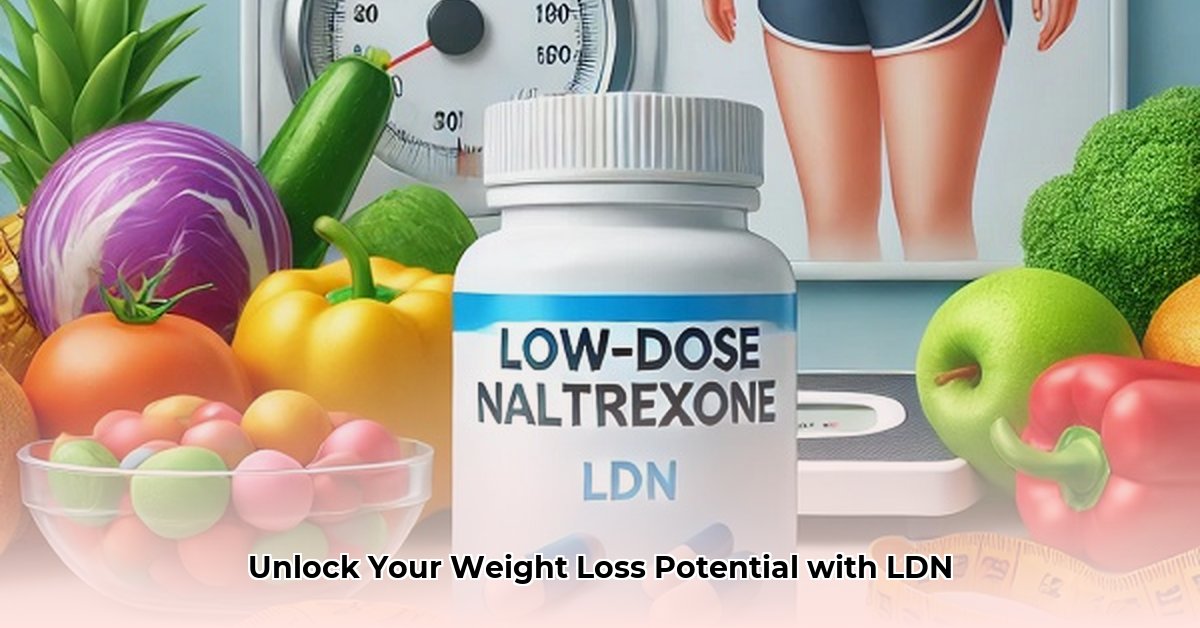
Losing weight can be challenging, and many seek additional support. Low-dose naltrexone (LDN), while not FDA-approved for weight loss, has shown promise in some studies. This guide provides information to help you understand LDN's potential role in weight management and how to use it safely, always in consultation with your physician.
Understanding Low-Dose Naltrexone (LDN) and Weight Loss
LDN, used at significantly lower doses than for opioid addiction, may affect weight loss through several mechanisms. Research suggests it might influence appetite regulation, potentially leading to reduced food intake. Additionally, some studies indicate anti-inflammatory effects, which could be beneficial as inflammation is often linked to weight gain. However, the exact mechanisms and efficacy are still being investigated. It's crucial to remember that the FDA hasn't approved LDN specifically for weight loss; its use for this purpose is considered "off-label."
Low Dose Naltrexone for Weight Loss Dosage: A Personalized Approach
Determining the right LDN dosage is highly individualized. Studies have employed various doses (1.5mg to 4.5mg), but there's no one-size-fits-all answer. Your doctor will play a crucial role, often starting with a low dose (e.g., 1.5mg) to assess your response and adjust accordingly. This requires close monitoring and open communication with your healthcare provider. Results are not immediate; consistent effort and patience are key.
LDN and Weight Loss: A Holistic Strategy
LDN should be viewed as a component of a comprehensive weight loss plan, not a standalone solution. A balanced diet rich in fruits, vegetables, and lean protein, coupled with regular exercise, remains the foundation of successful weight management. LDN might provide additional support, but lifestyle changes remain essential for long-term success. How can you best incorporate LDN into your broader weight loss strategy?
Potential Benefits and Risks of LDN for Weight Loss
While LDN offers potential benefits, such as appetite control and improved insulin sensitivity, it's important to be aware of potential side effects. These are typically mild (e.g., vivid dreams, nausea, fatigue), but it's imperative to report any concerns to your doctor. They can help you weigh the potential benefits against the risks based on your individual health profile. Is the potential reward worth the risk for you?
Steps to Safely Incorporate LDN into Your Weight Loss Plan
Here's a structured approach to safely using LDN for weight loss:
Consult Your Doctor: The initial step is a thorough discussion with your physician. They'll assess your medical history, current medications, and weight loss goals to determine if LDN is appropriate.
Start Low, Gradually Adjust: Your doctor will likely start you on a low dose (typically 1.5mg) and gradually increase it based on your response and any side effects. Self-adjusting the dosage is extremely dangerous and should never be undertaken.
Prioritize Lifestyle Changes: Maintain a healthy diet and regular exercise program. These remain cornerstones of successful weight loss and will significantly amplify LDN's potential benefits.
Monitor for Side Effects: Closely monitor how you feel and report any side effects, even minor ones, immediately to your doctor.
Maintain Open Communication: Regular communication with your doctor enables them to fine-tune your treatment and monitor for any adverse reactions or changes. This is a collaborative process.
LDN Compared to Other Weight Loss Methods
Various weight loss methods exist, each with its pros and cons. Understanding LDN's place within this landscape is crucial:
| Method | Advantages | Disadvantages | Side Effect Risk | Success Rate Variation |
|---|---|---|---|---|
| Low Dose Naltrexone | Potential appetite control, may reduce inflammation | Off-label use, variable dosing, limited long-term data | Low to Moderate | Moderate |
| Contrave | FDA-approved, demonstrated effectiveness in some studies | Potential side effects, can be expensive | Moderate | Moderate |
| Phentermine | Rapid short-term weight loss | Significant side effects, dependence potential | High | Generally High |
| GLP-1 Agonists | Significant weight loss, improves metabolic health | High cost, potential side effects | Low to Moderate | Generally High |
| Orlistat | Relatively safe, blocks fat absorption | Frequent gastrointestinal upset | Moderate | Moderate |
Note: This table offers a general comparison. Individual experiences may differ significantly. Consulting your physician is crucial for personalized recommendations.
How to Safely Increase Low Dose Naltrexone for Weight Loss: A Gradual Approach
Increasing LDN dosage must be done under strict medical supervision. Never attempt to adjust your dosage without consulting your doctor. The process typically involves:
Initial Consultation: A detailed discussion with your doctor to assess your health and establish goals.
Low Starting Dose: Your doctor will initiate treatment with a low dose.
Gradual Increments: The dose is increased incrementally based on your body's response and any potential side effects. This usually occurs over weeks to months.
Regular Monitoring: Consistent checkups allow your doctor to monitor your progress and make necessary adjustments.
Lifestyle Integration: A balanced diet and regular exercise are integral to maximizing LDN's effectiveness.
Key Considerations
- LDN's role in weight loss is still being researched.
- Working closely with a doctor is essential for safe and effective use.
- Gradual dosage increases are critical to minimize potential side effects.
- Lifestyle changes are indispensable for long-term weight management.
- Contrave, an FDA-approved medication, presents a more established alternative.
Remember, this information is for educational purposes and does not constitute medical advice. Always consult your physician to determine if LDN is appropriate for your individual needs and circumstances.